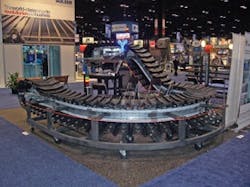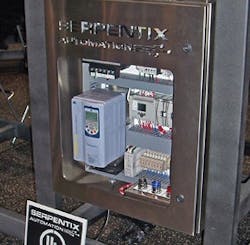Jim Montague is the executive editor for Control, Control Design and Industrial Networking. Email him at [email protected] or check out his Google+ profile.
Spoiler alert! This story has many twists and turns!
Maybe because they look so much like rivers, most sophisticated conveyors and material handling systems seem like they've been elegantly and effortlessly flowing along forever. However, the folks that manufacture and install them know it takes plenty of work for a continuous conveyor to make its job look easy and graceful, especially in tight spots and other difficult applications.
SEE ALSO: Conveyor Collaboration Lets One Drive Do Job of Four
For instance, Serpentix Conveyor in Westminster, Colo., has designed and built conveyors since 1969, and has been constantly expanding and improving on its continuous-path models during those almost 45 years. While traditional wisdom says the shortest path between two points is a straight line, Serpentix's engineers know that curves are better because it can take many connected straight paths and flat belts to reach a desired location, which takes more time and is less efficient.
Figure 1: Serpentix's Pathwinder continuous path conveyor is more efficient than multiple straight conveyors, and recently engineers added VFDs, wireless routers and even smartphone-enabled controls.
"Operating over a continuous, three-dimensional path, Serpentix easily outperforms and costs less than conventional conveyors that can only operate along a straight line," says Robert Nusz, Serpentix's president and sales director. "The ability to incline steeply and make continuous horizontal, helical and vertical curves lets one Serpentix conveyor replace multiple conventional conveying devices, eliminating troublesome transfer points and reducing energy use, space and maintenance costs. Many older factories that are cramped for space use Serpentix conveyors to modernize without increasing their size, while new facilities use them to reduce construction, installation and operating costs."
Though Serpentix's drag conveyors are chain-driven, they maintain a low, power-saving 0.15 friction coefficient by using ultra-high, molecular weight polyurethane (UHMWPE) guide blocks and channels, which are water-submersible and more durable than rollers and bearings that generate more friction. In addition, positive tracking of the blocks and channels prevents Serpentix's chains from drifting out of alignment. And each individual, 8-in.-wide, polyethylene, belting pan segment is easy to remove and repair or replace, which costs less than replacing larger, traditional flat-belt parts and sections.
This flexibility is useful because Serpentix's conveyors are mostly used to move dewatered sludge generated by wastewater treatment plants, though they're also used to transport paper pulp, food ingredients and biomass material. The conveyors also preserve the physical properties of the dewatered sludge they handle and don't reduce its viscosity, which can occur due to the shearing action of typical screws and pump systems. Similar to loose ground in an earthquake, sludge can liquefy when agitated.
New Curve Learning
The company's third-generation Pathwinder continuous path conveyor is 12 years old, but it has had many innovations added along the way and increased its design life from 10 years to 15 (Figure 1). These conveyors can be as short as 8 feet or as long as 300 feet and move up to 100 tons per hour.
Pathwinder uses WEG variable-frequency drives (VFDs) and Weidmüller terminal blocks and power receptacles, which are controlled by Rockwell Automation PLCs. More recently, Serpentix incorporated a Linksys Wi-Fi router that communicates with the PLC and allows the conveyor to be controlled via a smart phone application. Pathwinder uses Scada Mobile's Sweet William iPhone app.
Figure 2: Serpentix launched its own control and panel-building division this past July to capitalize on constructing and integrating many components that it used to outsource.
"So if there's an e-stop on the conveyor, it will sound an alarm klaxon on the user's iPhone," says Anthony Janssen, Serpentix's automation specialist and general manager. "We can then reset the fault with the same ScadaMobile app and then re-enable and start the conveyor again. If we're applying this method in the field, we'll use Phoenix Contact's VPN router. Of course, the inspiration for all this is that users want to control their third-generation conveyors from the booth and not have to go out to them as often."
In-House Integrating
Beyond adding remote control and other new media features, Serpentix reports it just started an in-house controls and panel building division in July to better integrate ongoing updates and innovations in its control capabilities, and deliver the most useful ones to each customer (Figure 2).
"We previously outsourced our panels and controls to existing OEMs for our customers, but we've been getting enough of this business recently to justify doing it ourselves, so I was added," Janssen says. "A lot of Serpentix's users need local controls and panels, but there's also other controls business we can do. This is similar to the OEMs that we worked with a lot in the past, who serve users in the oil and gas, food and beverage, mining, HVAC and other fields. We just build the controls and the panel, but we don't do the whole panel. So we're different than a system integrator, but we're headed in that direction. Our new owner is pretty growth-minded, and while our conveyor business is steady, we see controls as having some real growth potential."








